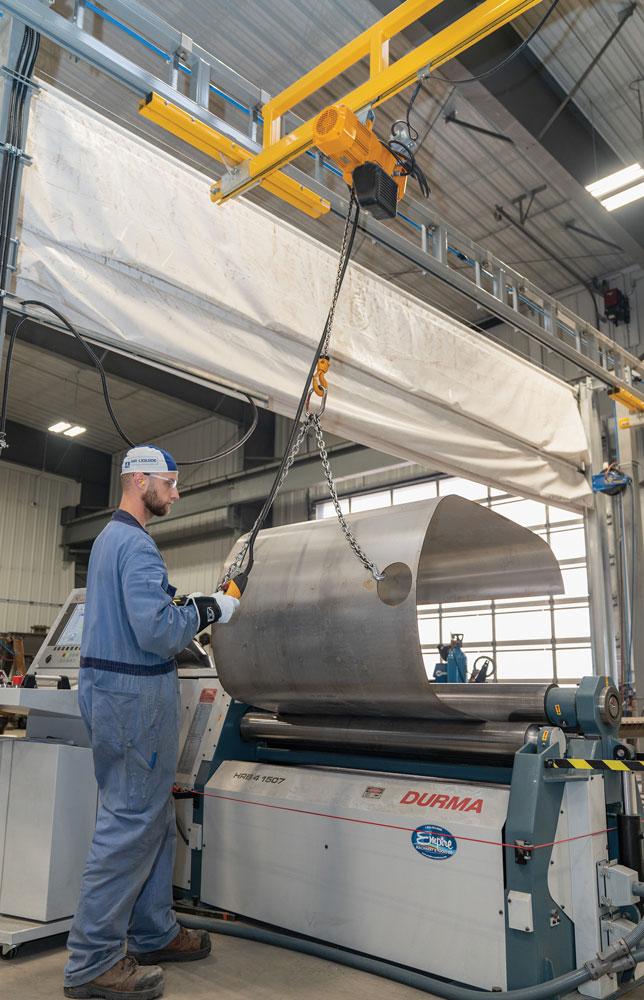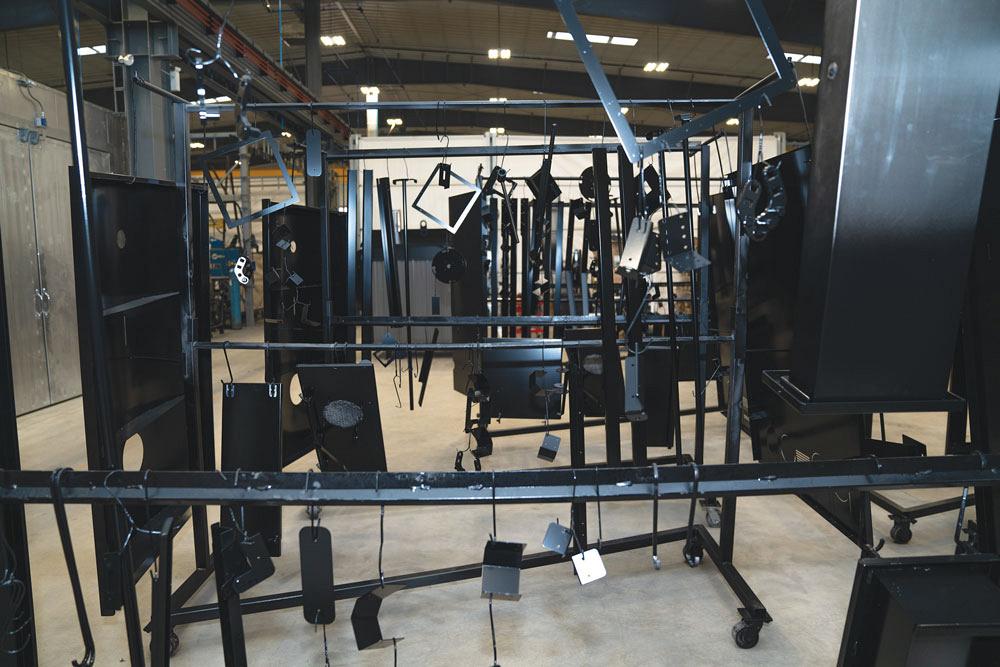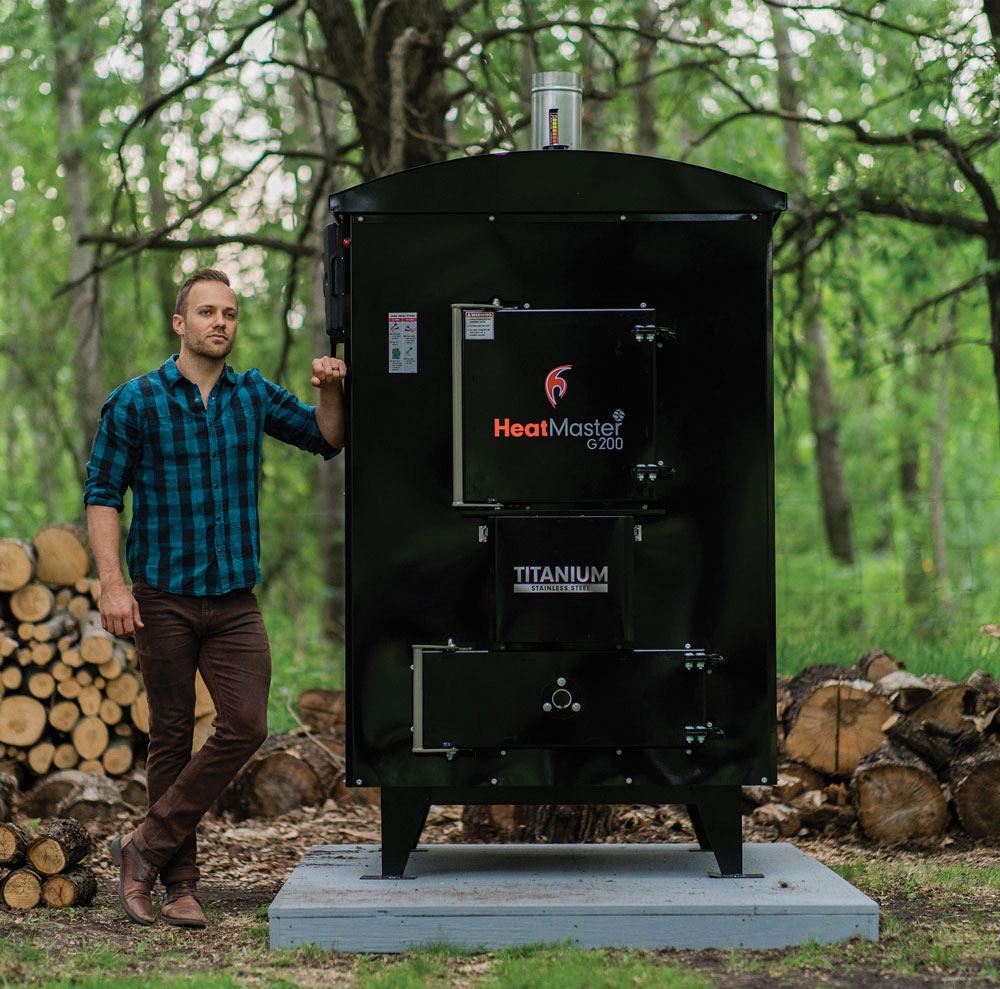Editor
- FMA
- The Fabricator
- FABTECH
- Canadian Metalworking
SteelTech moves toward automation, step by step
Winkler, Man., biomass-burning furnace manufacturer aims for longevity in its products and processes
- By Rob Colman
- November 20, 2019
- Article
- Fabricating

Quality and longevity is critical for Jake Friesen in making his products, so he chooses his materials carefully. The shop uses 409 stainless steel for any parts that are going to be exposed to high temperatures, and the exteriors are made of Galvalume®-coated steel.
A quality product usually stands out for its users for two reasons: It does what it does better than competitive products in the market, and it’s solidly built. But for a product to remain viable, its manufacturer has to continually find ways to make production more efficient, without affecting output quality.
This is something Jake Friesen, founder and co-owner of SteelTech Inc., has been doing since he first started producing wood-burning furnaces under the HeatMasterss brand in 2001. Over time the product has become more advanced, and the shop’s fabrication processes have worked to keep up with that shift.
Product Sophistication
In just less than 20 years the HeatMasterss product has come a long way.
“The furnace we first started fabricating in 2001 could heat between 5,000 and 10,000 sq. ft., and you had to go load it and do maintenance on it two to three times a day, like the sort of wood stove you might have inside your house,” said Friesen. “Today our furnaces can go at least a week without any maintenance. It’s all automated. And our largest units can comfortably heat 50,000 sq. ft.”
The fuel options for the furnaces also have changed; some units can burn a variety of biomass, including food and agricultural waste, as well as wood chips and pellets.
“We are now working with a cabinet-maker that employs between 200 and 300 people to take their waste product and turn it into fuel for them,” said Friesen. “Not only will they no longer have to pay to have that scrap carted away, but they will also save money on heating costs. We can produce heat for 2 cents per kilowatt compared to standard rates of about 10 cents a kilowatt. For most people, the payback on a unit is two to three years, but for this company it will likely be closer to one year.”
The efficiency of these furnaces, and their appeal as an off-grid, carbon-neutral heat source, makes the future look bright for the Winkler, Man.-based business. And Friesen is preparing for growth in a new, 35,000-sq.-ft. facility that was completed in June.
Family Fabricator
The business started in a 3,200-sq.-ft. shop run essentially by Friesen on his own, although his wife Mary Ann helped out as necessary. Visit the HeatMasterss website (heatmasterss.com) and you can see a video in which Friesen shares a photo of his wife running the shop’s saw in the early days. It’s a good reminder of how all family businesses grow – with everyone pitching in as needed.

The shop’s new CNC folding machine helps with one-piece part flow. All the company’s product models are preprogrammed so that any product can be run through the machine at any time.
In the first year, while Friesen did the fab work, all the welding was contracted out. After that first year, Friesen brought his welder, Ben Wall, in as a business partner.
“We have always done our own fabrication work, except in those times when orders grew faster than the shop,” said Friesen. “Then we might farm out some paint work or welding. In 18 years, we’ve gone through five expansions.”
Those subcontracting days seem to be behind the company now, though. With the new facility, they are preparing to quadruple production over a period of a few years. The building is on land that will allow the shop to double its square footage over that time. Perhaps more importantly, though, many processes are gradually being automated to eliminate part handling.
Helping in this transition is the next generation of Friesens – Jake and Mary Ann’s three boys. They are gradually taking over day-to-day operations. Ryan serves as general manager, Derek is production manager, and their youngest, Devon, is working toward taking over the role of sales manager. Meanwhile, Jake aims to focus more on R&D work. The shop now employs a little more than 50 employees, including an engineering department of four (supported by Friesen and his business partner).
Material Quality
Wood furnaces aren’t a product unique to HeatMasterss, of course. But quality is in the materials you use to build a product as well, and Friesen uses material that is built to last.
“We use 409 stainless steel for any parts that are going to be exposed to high temperatures,” said Friesen. “It’s not very common in our industry. It doesn’t really require a lot of specialty equipment but needs specialty knowledge to work it well in the fabrication process. Our competitors have tried it and moved away from it. We’ve gained knowledge of it through trial and error. What it means for our customers is that we can produce a furnace that will last twice as long as other units.”
409 stainless has a higher titanium and chromium content than other stainless steels and a lower nickel content. It’s most commonly used in exhaust systems for automobiles and other, similarly sophisticated applications.
Balancing the Product Mix
The move to the new facility essentially involved amalgamating four different buildings under one roof, while also streamlining production by adding new processes and tools. As Friesen noted, “The move itself was a full-time job.”

SteelTech recently added a mid-range Durma plate roller to its lineup of plate rollers. It is used for the interior of mid-range boilers.
The biggest challenge right off the top is the product mix. While the shop is strictly a furnace manufacturer, it still has 11 different models that it builds to order. While there are clearly some parts and certain models that the company produces regularly, speedy delivery to customers requires them to be able to adapt to orders as they arrive.
That makes running the shop’s Mitsubishi laser a balancing act. The shop has had the 4-kW CO2 laser a couple years but with the move introduced a new SmartFlex Rapid 3015 load/unload system. With this system, the company can run the machine lights-out, but the nature of the work means they have to manage lights-out production carefully.
“What we’re doing now is running more common parts or larger orders lights-out on the laser overnight, while during the day we can program shorter-run parts, rush jobs, or R&D jobs,” said Friesen. “We’ve found a good balance in that way for the time being. In the process of adding part sorting, we’re learning to do better planning and looking ahead further.”
The shop will introduce a tower system to complement the load/unload system shortly, simplifying the storage and movement of raw sheet, remnants, and completed parts.
Forming on Demand
Forming in the shop is taken care of by three plate rollers, three press brakes, and one folding machine.
The folding machine is another new addition to the shop, a Roper Whitney CNC model purchased from Empire Machinery. This is primarily used to bend Galvalume®-coated steel used for the exterior of the furnaces. Galvalume is a coating consisting of zinc, aluminum, and silicon that protects the steel from oxidation.
“The folder, being a CNC machine, helps us with one-piece part flow,” said Friesen. “With our 11 different models, we want to build whatever the customer needs as they need it. All the models we have are preprogrammed, so running the folder is flexible and agile. Also, the folder operates in such a way that it doesn’t scratch the material, which is critical when you’re working with parts that are already coated.”
SteelTech recently added a mid-range Durma plate roller (also purchased from Empire) to its lineup of plate rollers.
The smallest plate roller is used to roll chimneys. The other two are used for the interior boilers.

SteelTech is gradually improving part flow throughout its new facility. Here we see a manual conveyor designed to simplify loading of the shop’s plate rollers.
“Our boilers are designed wherever possible with a round design because they are stronger structurally, and that ties in with our wanting to make a product with longevity built in,” said Friesen. “Mid-range boilers are a big part of our market, so getting a mid-sized plate roller to manage that product flow was important for us.”
Automation Everywhere
The plant is also currently working with ABB to transition to robotic welding for its boiler tanks.
“Everything in the shop is moving towards automation,” said Friesen. “Everything is geared towards expansion and automation, managed in steps. You can’t automate it all at once, but if you don’t keep moving towards full automation, you’ll be a dinosaur in a few years.” The company’s paint line is no exception to that rule either. SteelTech recently transitioned to powder coating from wet paint.
“Staff is still getting used to the powder coating process,” said Friesen. “Our research suggested that powder suited our product line, again in terms of its longevity, but also employee safety and environmental impact. Ultimately, this process will be automated as well.”
In tandem with all of these process and machine upgrades, Friesen is also in the process of monitoring part flow from one area of the shop floor to the next, finding out what the missing links are between one machine and the next, determining how to make the shop run as smoothly as possible.
“We moved into the new building in June of this year,” said Friesen. “I expect it will take until June of next year before everything is running as smoothly as I believe it ultimately should. With the many different processes we’ve upgraded, a lot of retraining is taking place. It takes time.”
Asked what the biggest takeaway for him was in this transition, Friesen didn’t hesitate.
“You need to know and trust your suppliers,” he said. “Whether it’s your building contractors or your equipment suppliers. This kind of shift is too much for one management team. Known, reliable suppliers are critical to minimize timelines and costs and maintain efficiencies.”
Next Steps

SteelTech recently transitioned to powder coating from wet paint. Eventually this process will be automated.
SteelTech’s transition to automation is being closely matched by its product innovations. Friesen only sees this continuing into the future.
“Right now we’re just producing heat for buildings with our product,” he said. “The next step will be co-generation – generating both heat and electricity with biomass waste.”
That drive for innovation is finding a place on the shop floor as well. The SteelTech team is currently working on developing some homemade automation for the plant to meet its unique needs.
This is where Jake Friesen looks forward to spending more of his time in future as his boys take care of day-to-day operations. “Innovation is my passion.”
Editor Robert Colman can be reached at rcolman@canadianfabweld.com.
SteelTech Inc., www.heatmasterss.com
About the Author

Rob Colman
1154 Warden Avenue
Toronto, M1R 0A1 Canada
905-235-0471
Robert Colman has worked as a writer and editor for more than 25 years, covering the needs of a variety of trades. He has been dedicated to the metalworking industry for the past 13 years, serving as editor for Metalworking Production & Purchasing (MP&P) and, since January 2016, the editor of Canadian Fabricating & Welding. He graduated with a B.A. degree from McGill University and a Master’s degree from UBC.
subscribe now


Keep up to date with the latest news, events, and technology for all things metal from our pair of monthly magazines written specifically for Canadian manufacturers!
Start Your Free Subscription- Trending Articles
Aluminum MIG welding wire upgraded with a proprietary and patented surface treatment technology

CWB Group launches full-cycle assessment and training program

Achieving success with mechanized plasma cutting

Hypertherm Associates partners with Rapyuta Robotics

Brushless copper tubing cutter adjusts to ODs up to 2-1/8 in.

- Industry Events
MME Winnipeg
- April 30, 2024
- Winnipeg, ON Canada
CTMA Economic Uncertainty: Helping You Navigate Windsor Seminar
- April 30, 2024
- Windsor, ON Canada
CTMA Economic Uncertainty: Helping You Navigate Kitchener Seminar
- May 2, 2024
- Kitchener, ON Canada
Automate 2024
- May 6 - 9, 2024
- Chicago, IL
ANCA Open House
- May 7 - 8, 2024
- Wixom, MI
















